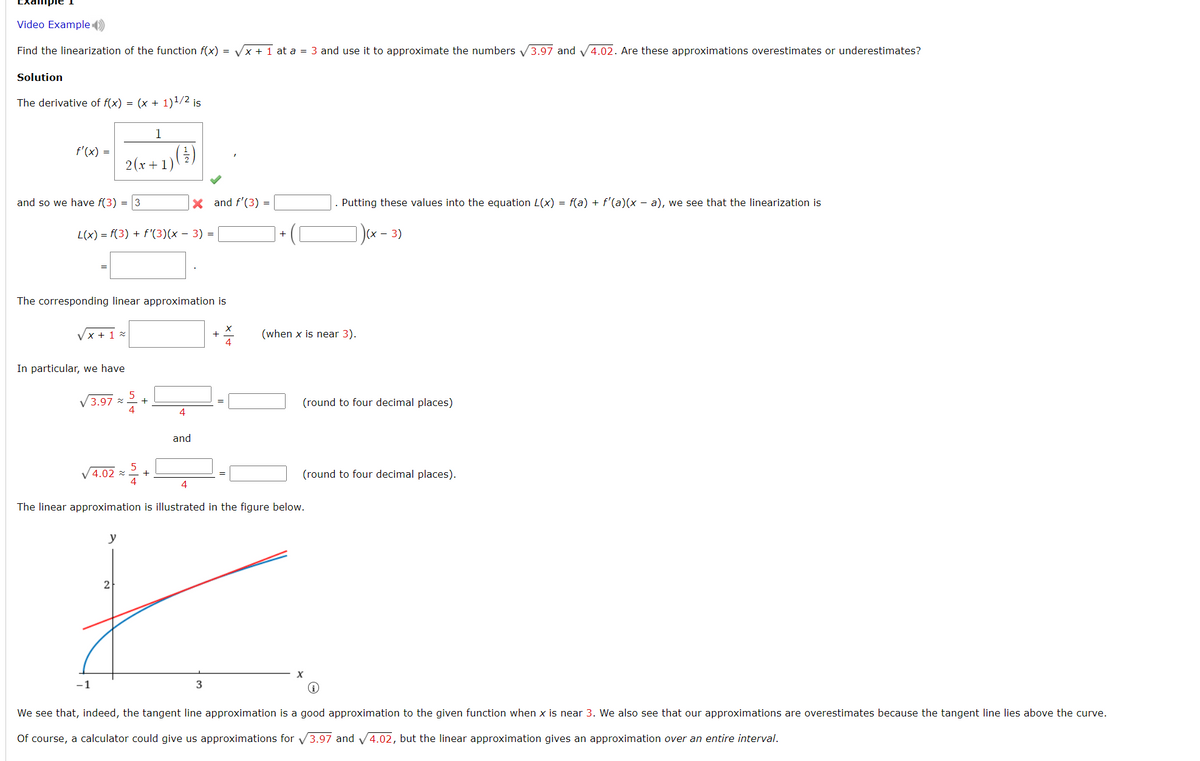Video Example Find the linearization of the function f(x) = Vx + 1 at a = 3 and use it to approximate the numbers V3.97 and V4.02. Are these approximations overestimates or underestimates? Solution The derivative of f(x) = (x + 1)1/2 is f'(x) = 2(x +1 and so we have f(3) = 3 x and f'(3) = Putting these values into the equation L(x) = f(a) + f'(a)(x - a), we see that the linearization is L(x) = f(3) + f'(3)(x - 3) = | (x - 3) The corresponding linear approximation is Vx +1* (when x is near 3). In particular, we have V3.97 = (round to four decimal places) 4 and 4.02 (round to four decimal places).
Video Example Find the linearization of the function f(x) = Vx + 1 at a = 3 and use it to approximate the numbers V3.97 and V4.02. Are these approximations overestimates or underestimates? Solution The derivative of f(x) = (x + 1)1/2 is f'(x) = 2(x +1 and so we have f(3) = 3 x and f'(3) = Putting these values into the equation L(x) = f(a) + f'(a)(x - a), we see that the linearization is L(x) = f(3) + f'(3)(x - 3) = | (x - 3) The corresponding linear approximation is Vx +1* (when x is near 3). In particular, we have V3.97 = (round to four decimal places) 4 and 4.02 (round to four decimal places).
College Algebra (MindTap Course List)
12th Edition
ISBN:9781305652231
Author:R. David Gustafson, Jeff Hughes
Publisher:R. David Gustafson, Jeff Hughes
Chapter5: Exponential And Logarithmic Functions
Section5.5: Properties Of Logarithms
Problem 106E
Related questions
Question

Transcribed Image Text:пріе
Video Example )
Find the linearization of the function f(x)
= Vx + 1 at a = 3 and use it to approximate the numbers 3.97 and V4.02. Are these approximations overestimates or underestimates?
Solution
The derivative of f(x) = (x + 1)1/2 is
1
f'(x) =
2(x +1)
()
and so we have f(3) = 3
X and f'(3) =
Putting these values into the equation L(x) = f(a) + f'(a)(x - a), we see that the linearization is
L(x) = f(3) + f '(3)(x – 3) =
)(x - 3)
The corresponding linear approximation is
Vx + 1 2
(when x is near 3).
In particular, we have
3.97 2
4
+
(round to four decimal places)
4
and
4.02 z
4
(round to four decimal places).
4
The linear approximation is illustrated in the figure below.
-1
3
We see that, indeed, the tangent line approximation is a good approximation to the given function when x is near 3. We also see that our approximations are overestimates because the tangent line lies above the curve.
Of course, a calculator could give us approximations for V3.97 and V4.02, but the linear approximation gives an approximation over an entire interval.
Expert Solution
This question has been solved!
Explore an expertly crafted, step-by-step solution for a thorough understanding of key concepts.
This is a popular solution!
Trending now
This is a popular solution!
Step by step
Solved in 5 steps with 4 images

Recommended textbooks for you

College Algebra (MindTap Course List)
Algebra
ISBN:
9781305652231
Author:
R. David Gustafson, Jeff Hughes
Publisher:
Cengage Learning

College Algebra (MindTap Course List)
Algebra
ISBN:
9781305652231
Author:
R. David Gustafson, Jeff Hughes
Publisher:
Cengage Learning